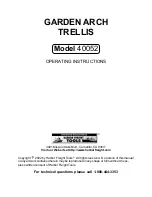
With a time coefficient of 0.5//s/cm and depressed
X-MAGN. X5
pushbutton, the example shown in the
above figure results in a measured total risetime of
ttot = 1,6cm -0.5jus/cm : 5 =
160ns
When very fast risetimes are being measured, the
risetime of the oscilloscope amplifier has to be deducted
from the measured time value. The risetime of the signal
can be calculated using the following formula.
tr = 1 / tto t2 — tosc2
In this ttot is the total measured risetime, and tosc is the
risetime of the oscilloscope amplifier (approx. 17.5ns
with HM203). If ttot is greater than 100ns, then ttot can
be taken as the risetime of the pulse, and calculation is
unnecessary (error smaller than 1 %).
Connection of Test Signal
The signal to be displayed should be fed to the vertical in
put of the oscilloscope by means of a shielded test cable,
e.g. the HZ32 or HZ34, or by a X I 0 or X I 00 attenuator
probe. The use of these shielded cables with high im
pedance circuits is only recommended for relatively low
frequencies (up to approx. 50kHz). For higher frequen
cies, and when the signal source is of low impedance, a
cable of matched characteristic impedance (usually
50Q) is recommended.
In addition, and especially
when investigating square or pulse waveforms, a
resistor equivalent to the characteristic impedance of
the cable must also be connected to the cable directly
at the input of the oscilloscope.
When using a 50Q
cable, such as the HZ34, a 50Q through-termination
type HZ22 is available from HAMEG. When investigating
square or pulse waveforms with fast risetimes, transient
phenomena on both the edge and top of the signal may
become visible if the correct termination is not used. It
must be remembered that the 50Q through-termination
will only dissipate a maximum of 2 watts. This power
consumption is reached with lO Vrm s or with 28Vpp
sine signal. If a X I 0 attenuator probe (e.g. HZ30) is
used, no termination is necessary. In this case, the con
necting cable is matched directly to the high impedance
input of the oscilloscope. When using attenuator probes,
even high internal impedance sources are only slightly
loaded (by approximately 10MQI112pF). Therefore,
when the voltage loss due to the attenuation of the probe
can be compensated by a higher sensitivity setting on the
HM203, the probe should always be used. Also it should
be remembered that the series impedance of the probe
provides a certain amount of protection for the input of
the oscilloscope amplifier. It should be noted that all
attenuator probes must be compensated in conjunction
with the oscilloscope (see: Probe Adjustment, page M4).
If a X I 0 or X I 00 attenuator probe is used, the
DC
input coupling must always be set.
With
AC
coupling,
the attenuation is frequency-dependent, the pulses
displayed can exhibit ramp-off, DC-voltage contents are
suppressed — but loads the respective input coupling
capacitor of the oscilloscope. The electric strength of
which is maximum 500V (DC-(-peak AC). For the sup
pression of unwanted DC voltages, a
capacitor
of ade
quate capacitance and electric strength
may be con
nected before the input tip of the probe
(e.g. for ripple
measurements).
With the HZ37 X I 00 probe, the permissible AC input
voltage is frequency-dependent limited:
below 20kHz
(TV line frequency!) up to
max. 1.500Vp - 3.000Vpp - 1.061 Vrms;
above 20kHz
(with f in MHz) up to
212 w
^
424
„
A
150
„
max.
Vp
a
—— Vpp
-
—=-
Vrms.
F
F
F
It is important to remember that when low voltage signals
are being investigated the position of the ground point on
the test circuit can be critical. This ground point should
always be located as close as possible to the measuring
point. If this is not done, serious signal deformation may
result from any spurious currents through the ground
leads or test chassis parts. This comment also applies to
the ground leads on attenuator probes which ideally
should be as short and as thick as possible. For the con
nection of a probe to a BNC socket, a BNC-adapter
should be used. It forms often a part of the probe
accessory. Grounding and matching problems are then
eliminated.
The location and quantitative measurement of a
magnetic leakage (e.g. from power transformer) into a
circuit is possible using a pick-up coil. If the coil has many
windings, it should be shielded against static fields (non
magnetic shield without short-circuited turn). Also the in
terconnection between coil and oscilloscope vertical in
put should be made by a shielded cable with BNC male
connector at one end. A resistor of approx. 100Q should
be connected in series between cable core and connec
tor core. This resistor attenuates radio-frequency excita
tion. The shieldings prevent any undesired capacitive
couplings. During measurement, use line triggering
(TRIGGER SELECTOR
switch to
LINE)
Hum or interference voltage appearing in the measuring
circuit (especially with a small deflection coefficient) is
possibly caused by multiple grounding, because through
it equalizing currents can flow in the shieldings of the
measuring cables (voltage drop between the non-fused
M7 20 3-4












































